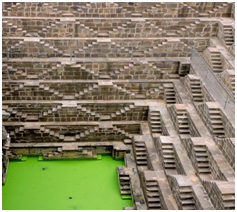

Context
Huge architectural gems built deep into the Earth like inverted fortresses are scattered around India – and restoring them may be a solution to help the country's parched communities.
What are Stepwells?
- Evidence of stepwells dates back to the Indus Valley Civilisationbetween 2500-1700 BC.
- Initially constructed as crude trenches, they slowly evolved into engineering marvels between 11th-15th Century.
- In 2016, Stepwell Atlas, mapped the coordinates of around 3,000 existing stepwells in India.
- Delhi, the capital, alone has 32 stepwells.
- Stepwells are multi-storied subterranean structures with significant ornamental and architectural features. They usually have two parts:
- a vertical shaft of water
- the cascading galleries, chambers and a flight of orchestrated steps
|
Water extraction in India
|
How Rajasthan is ahead in water conservation?
- In 2018, the government of Rajasthan drew up a comprehensive framework, with technical assistance from the World Bank, for restoration of the stepwells, including Chand Bawri.
- The Rajasthan government, through its flagship program Mukhyamantri Jal Swavalamban Abhiyan, has taken initiatives to make villages self-sufficient in water by reviving the non-functional rainwater harvesting structures.
|
Chand Bawri in Abhaneri, Rajasthan
|


